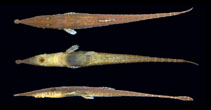| Family: |
Loricariidae (Armored catfishes), subfamily: Hypoptopomatinae |
| Max. size: |
5.55 cm SL (male/unsexed) |
| Environment: |
demersal; freshwater; depth range 0 - 1 m |
| Distribution: |
South America: Rio Tapajós drainage, Amazon River basin in Brazil. |
| Diagnosis: |
Dorsal soft rays (total): 8-8; Anal soft rays: 6-6. Distinguished from all congeners in possessing one series of middle abdominal plates between the lateral abdominal plates (vs. middle abdominal plates absent in remaining species). Differs from Acestridium dichromum (the most similar species) in having a small and rounded snout-tip spatulate projection (vs. large and oval spatulate projection), a thick pectoral-fin spine without serrae or slightly serrated (vs. very thick and strongly serrated in the inner face), posterior most lateral abdominal plate small (vs. large), and preanal plate approximately rectangular, with short lateral projections (vs. preanal plate cross-shaped, with large lateral projections) (Ref. 75792).
Description: D i+7; A i+5; P I,6; V i+5 (Ref. 75792). |
| Biology: |
Inhabits small forest creeks which are usually shallow (0.3-1.0 m deep, 5-10 m wide), with sandy bottom, clear or slightly black water, moderate water current and dense aquatic and marginal vegetation (Ref. 75792). |
| IUCN Red List Status: |
Least Concern (LC); Date assessed: 07 November 2018 Ref. (130435)
|
| Threat to humans: |
harmless |
Source and more info: www.fishbase.org. For personal, classroom, and other internal use only. Not for publication.

